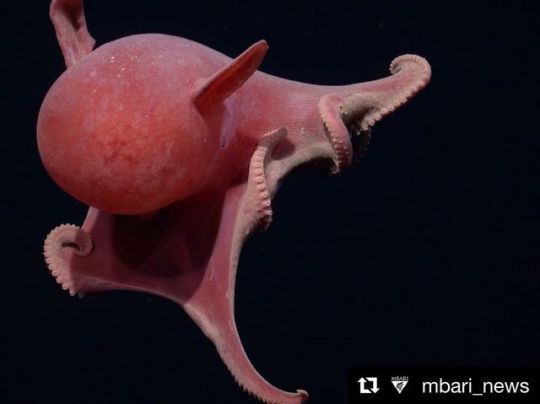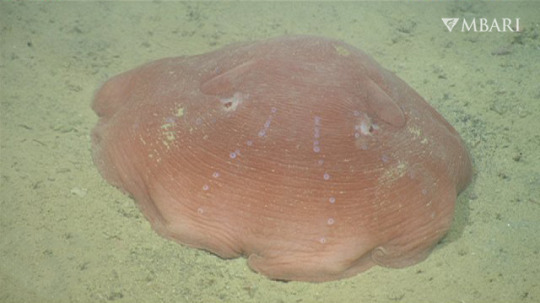#cephalomania
Text
Happy World Octopus Day!
This cephalopod cutie, Opisthoteuthis sp., is a cirrate octopus. A small pair of fins on their mantle and webbed arms allow them to either drift or pulse like a jellyfish just above the seafloor. Scientists believe the finger-like cirri lining each arm are used to detect and capture small prey such as crustaceans, polychaetes, and mollusks living in the mud.

Many cephalopods die shortly after they spawn, but Opisthoteuthis is able to continuously spawn throughout their lifetime. Their eggs require up to three years to develop and hatch. Given the length of time for egg development, we believe these species may be relatively long-lived, but little is known about their natural history. Learn more about this charismatic cephalopod on our website.
272 notes
·
View notes
Photo

The Crystal Palace Aquarium
After moving in 1854 to its (supposedly) permanent home on Penge Common, the Crystal Palace experienced the first of many fires in 1866, which led to the destruction of its northern end. The site was left desolate for a few years, until a plan was made to construct a marine aquarium, which opened in 1871.

It was briefly the largest of its kind in the world, holding (at least) 100,000 gallons of seawater. This was brought in by train from Brighton, and most was stored in great reservoirs below the floor level. Steam engines constantly pumped the seawater from the reservoirs below to the tanks above – 60 in all, with 38 for public display and 22 for research and storage. The display tanks varied from 40 to 4000 gallons in volume, containing (according to The Illustrated London News) “a large and varied collection of living marine animals, from very small ones to those of considerable size.” The most popular creature was an octopus, which delighted and terrified Victorians in equal measure, and contributed to the craze of cephalomania (said to have been started by the publication of Victor Hugo's novel Toilers of the Sea five years earlier, which featured a giant octopus).

Despite its wonderous displays, the aquarium was not a financial success. In the 1890s, the tanks were drained, and the marine creatures replaced with monkeys. The fire of 1936 that destroyed most of the Crystal Palace left the aquarium mostly untouched, but the demolition by dynamite of its neighbouring water tower in 1941 and construction of the transmitting station would leave only a small section remaining.

This can still be seen today, tucked away at next to the gates to the transmitting station and out of view form the more well-known remains of the Palace’s terraces. The remnants consist of three public tanks (with some original rock face at the rear), underfloor reservoirs (now filled with rainwater), areas where the steam engines would have been, and even the food preparation area and an office, plus a doorway which would have led to coal storage. The Crystal Palace Foundation has been involved in the excavation and conservation of the site, trying to make the site into more of a visitor attraction, and even hopes to one day restore one of the tanks to working use!
#london#uk#england#crystal palace#aquarium#ruins#marine#sea life#seawater#sea creatures#victorian#19th century#tanks#reservoirs#steam engine#pumps#animals#fish#octopus#cephalomania#fire#destruction#dynamite#remains#remnants#conservation#excavation#history#travel#tourism
368 notes
·
View notes
Photo

#Repost @mbari_news ・・・ Happy International Octopus Day! 🐙 These incredible animals certainly deserve some celebration! This Grimpoteuthis sp., (aka "Dumbo octopus) was spotted gliding gracefully through the dark water at 3,325 meters (10,908 feet). This group of octopuses is typically found on or near the seafloor where they use finger-like cirri on their arms to catch small crustacean, worms, and other prey items. We'll be showcasing more of our fantastic cephalo-friends this week as we celebrate Cephalopod Awareness Days, so stay tuned for all the cephalomania! #MBARI #deepsea #ocean #internationaloctopusday #WoldOctopusDay #OctopusDay #cephalopodawarenessdays #cephalomania #underwaterphotography #nature #explore #science #exploremore #wildlife #MontereyBay https://www.instagram.com/p/B3XR_x1hz-j/?igshid=tqtuqtkthlg2
#repost#mbari#deepsea#ocean#internationaloctopusday#woldoctopusday#octopusday#cephalopodawarenessdays#cephalomania#underwaterphotography#nature#explore#science#exploremore#wildlife#montereybay
1 note
·
View note
Text
#tfw you get aggressively booped by a Humboldt squid 😳
Growing up to two meters (nearly seven feet) long, Humboldt squid (Dosidicus gigas) are formidable predators that hunt krill and a variety of fishes. These scrappy squid hunt in large numbers along the coasts of both North and South America, from Chile to Baja California.
Researchers at MBARI have suggested that, as they hunt, these squid communicate with each other using changing patterns of light and dark pigment on their skin. The changes are visible even in the darkest depths of the ocean because the squids’ entire bodies glow in the dark, so the patterns are backlit like words on an e-reader screen.
371 notes
·
View notes
Text
Say hello to a cephalopod you should know—the corkscrew squid, Planctoteuthis danae. 👋🏼🦑
We're kicking off Cephalopod Week, aka our favorite week of the year, with this extraordinary denizen of the deep. MBARI's remotely operated vehicles (ROVs) have encountered the relatively rare deep-sea squid Planctoteuthis oligobessa fewer than 20 times in over 30 years.
This species' long, decorative tail remained unknown until MBARI ROVs captured the first images of the animal out in the wild. In trawl nets, many delicate deep-sea animals are damaged, so we often don't get the whole picture until we can take ROVs equipped with cameras into their environment.

Other squids in the family Chiroteuthidae also have ornate tails that they use for various reasons, like imitating siphonophores.
As we continue to dive into the depths of our ocean, MBARI researchers are discovering more about the species that live in this vast, mysterious habitat.
485 notes
·
View notes
Video
Gracefully gliding through the week with a fantastic flapjack. 😍🥰
These deep-sea octopuses use the movement of their large fins and arms to propel themselves through the water. They are affectionately called the “dumbo” octopuses because of those flapping fins. This group of octopuses is typically found on or near the seafloor, where they use finger-like cirri on their arms to catch small crustaceans, worms, and other prey items.
158 notes
·
View notes
Video
Happy World Octopus Day! Anyone want an octo hug? 🤗
Hiding among a prickly pile of sea urchins, this little red octopus, Octopus rubescens, makes a valiant attempt at grabbing its next meal—a wandering spot prawn. These clever cephalopods can change their color and texture to match their surroundings. Their typical diet ranges from small crabs and other crustaceans to mollusks and fishes.
MBARI’s remotely operated vehicles reveal astonishing interactions like these. We are building a baseline understanding of the deep sea that will be critical in determining how climate change, pollution, and mining may affect communities in the largest living space on Earth.
127 notes
·
View notes
Video
It is true. Mondays make us ink too.
This deep-sea squid, Bathyteuthis berryi, is a rare sight. We’ve only seen it seven times in over three decades of deep-sea exploration with our remotely operated vehicles. The shallowest sighting occurred at 942 meters (3,090 feet) and the deepest at 1,424 meters (4,670 feet). Each time we did get a glimpse of one of these remarkably scarce squid, they were either motionless at first sighting or were gently undulating the edges of their fins, apparently relying on neutral buoyancy to maintain their vertical position.
150 notes
·
View notes
Video
When you’re just casually rolling through Cephalopod Week, and bump into your favorite flappy ceph! 🤩
MBARI’s robotic submersibles often spot this little octopus resting on the mud, its orange body resembling a flat, fluffy pancake. When startled by a predator, a flapjack octopus perks up and swims to safety by flapping its stubby fins, pulsing its webbed arms, pushing water through its funnel for jet propulsion—or all three at once. When the coast is clear, it stretches its webbed arms and parachutes back to the seafloor.

Flapjack octopuses (Opisthoteuthis spp.) can grow up to 20 centimeters (nearly eight inches) across. They're typically found at depths between 130 and 2,350 meters (430 and 7,710 feet) where they feed on small worms, crustaceans, and other invertebrates. Learn more about these charming cephalopods on our Creature feature page.
137 notes
·
View notes
Video
Cephalopod Week 2022 has finally arrived, and the gang’s all here to celebrate!
This group of galatheid crabs and deep-sea octopus, Muusoctopus sp., was recorded on Alarcón Rise in the Gulf of California. The hydrothermal chimneys at Alarcón Rise are spectacular geologic formations 2,300 meters (7,545 feet) below the surface of the Gulf of California. Due to their unique and fascinating qualities, we still have a lot to learn about hydrothermal vents and their surrounding communities. Studies conducted at MBARI in collaboration with partnering institutions are shedding light on many unanswered questions about these amazing areas.
92 notes
·
View notes
Video
Does anyone else need some ceph-ASMR?
MBARI’s robotic submersibles often spot this little octopus resting on the mud, its orange body resembling a flat, fluffy pancake. When startled by a predator, a flapjack octopus perks up and swims to safety by flapping its stubby fins, pulsing its webbed arms, pushing water through its funnel for jet propulsion—or all three at once. When the coast is clear, it stretches its webbed arms and parachutes back to the seafloor.
Flapjack octopuses (Opisthoteuthis spp.) can grow up to 20 centimeters (20 inches) across. They're typically found at depths between 130 and 2,350 meters (430 and 7,710 feet) where they feed on small worms, crustaceans, and other invertebrates.
264 notes
·
View notes
Video
Mellow mornings with a seven-armed octopus 🐙
Haliphron atlanticus, also known as the seven-armed octopus, has been observed by MBARI’s remotely operated vehicles less than five times in over 30 years. In this species, the male keeps the hectocotylized arm hidden, so it appears to be missing, which is where its common name comes from.
Researchers have observed individuals of this species holding the bell of an egg-yolk jellyfish (Phacellophora camschatica) in their arms. During these encounters, the octopus had apparently eaten most of the tissue that would have been hanging down from the bell, but the ring of jellyfish tentacles was intact. It looked as though Haliphron had not only made a meal of the jelly but was hanging onto it, perhaps for defense or for help in catching prey. Haliphron is a member of the family Argonautidae, and now four genera in the family have been observed having some kind of relationship with salps or jellyfish—living on, in, or with the jelly.
34 notes
·
View notes
